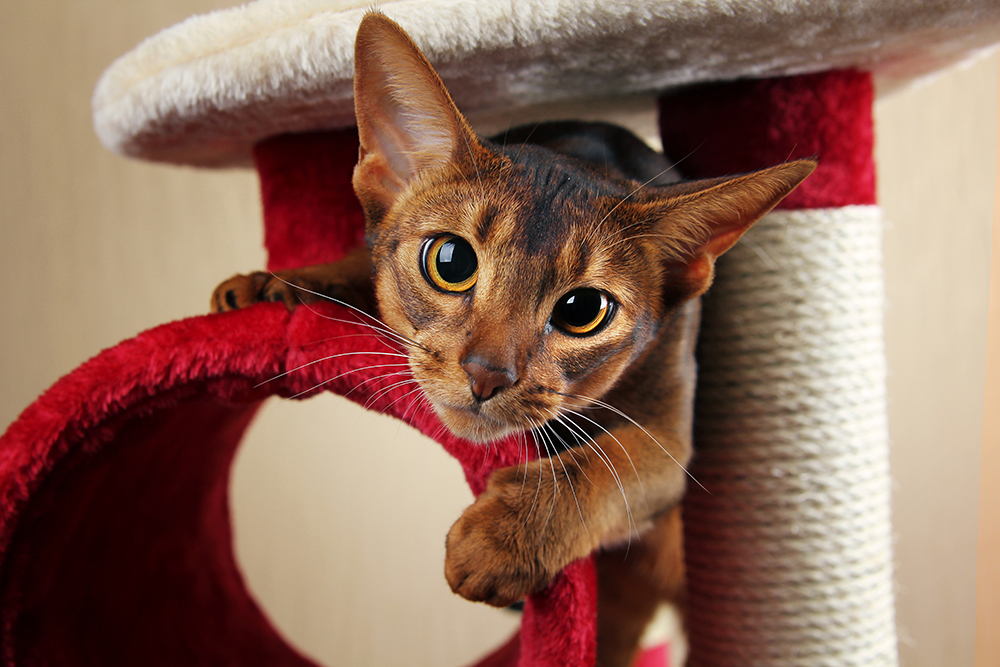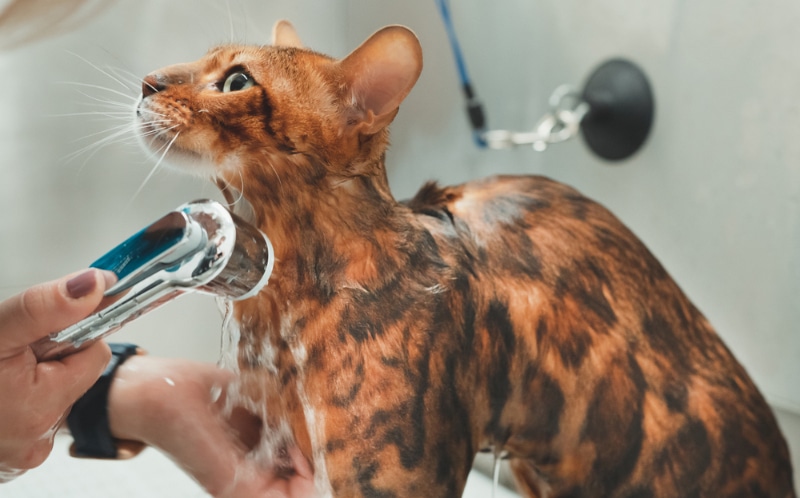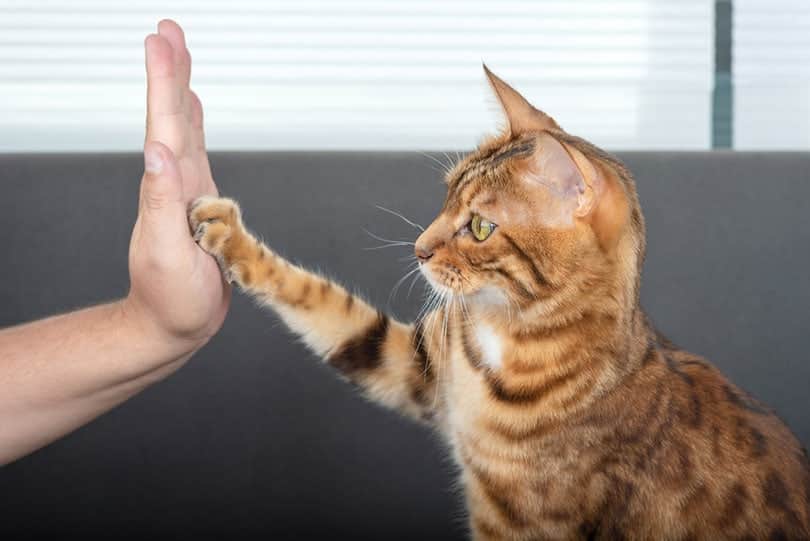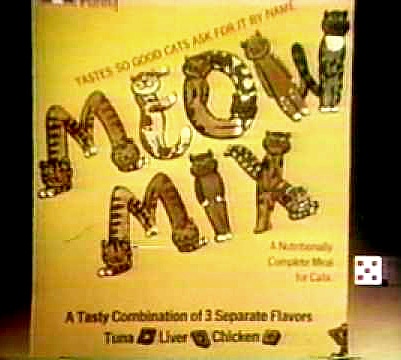
Meow Mix seizing upon our passions illustrates, for better or worse (we would argue the latter in many cases), the extent that products and brands influence our lives and identities. To paraphrase a Big Idea espoused by Joseph Campbell, among others, things such as commercial brands, movies, and professional sports have taken the place of the gaping hole in our culture once occupied by allegories from myth and religion. In other words, for modern-day models of living we turn largely to things and characters created by for-profit companies rather than stories passed down through the ages via spiritual or philosophical institutions, some of which steadfastly refuse to adapt to modern life. (See also: Why do you think “Star Wars” is so powerful to so many people? Hello, archetypes! How’s that hero’s journey going for you, Luke?)
Warren Dotz and Masud Husain take on a sliver of this modern-day mythology pie in Cat Food for Thought, a book containing labels from cat food (and litter and nip) from the 1950s through the 1970s. It also contains memorable quotes regarding cats and life with them.
The book contains dozens of labels in a variety of graphic design styles. Some seem downright archaic (but still really cute), while some look like they were created by the staffers on Mad Men, and others — with phrases such as “Meat Flavor” in prominent type — make you laugh at what obviously then didn’t seem funny (maybe). We received a copy of the book and contacted Dotz and Husain for an interview, excerpts of which are below along with a sampling of quotes from the book.
Catster: What moved you to publish Cat Food for Thought?
Warren Dotz: As an author and collector, I’ve always been attracted to the graphic design beauty of everyday product labels. I’m also a pet person, both cats and dogs. There was this wonderful “Sassy brand” cat food label whose cute image I was ogling on an auction website. And I thought, “Wouldn’t it be great to write a lovely book about two of my favorite subjects, pets and product label art!”

Where did you find them? They’re remarkably reproduced.
WD: Well, there was no one to turn to who actually collected this kind of stuff. But my co-author and I think of ourselves as pop culture explorers and just decided to see what was out there. Some were obtained from people who collect vintage labels in general, but most were just put up on auction sites, as I assume they were discovered in old garages and kitchen cabinets. The turning point for the book really came when I struck gold with a huge collection of labels not saved by a collector, but rather from the estate of a pet food company executive. In one fell swoop, I had hundreds of labels. Common ones, rare ones, and one-of-a-kind ones.
Masud is an expert on digitally restoring the labels for reproduction for our books. I see my role in my book projects as a “curator” and I believe the labels should sparkle as if they came off a can “yesterday,” even though they are 50 years old. So no old, bleached-out and mildewed-spotted labels for me or any of my design books.
Masud Husain: I do branding and packaging for a living. My experience with packaging and as a package designer gives me an understanding for what a label should look like. This helps me restore the label digitally. There is some decision-making while doing it. By fixing one area, you may move away from the label’s authenticity so you have to clean the labels in a way that leaves them looking cohesive and natural.
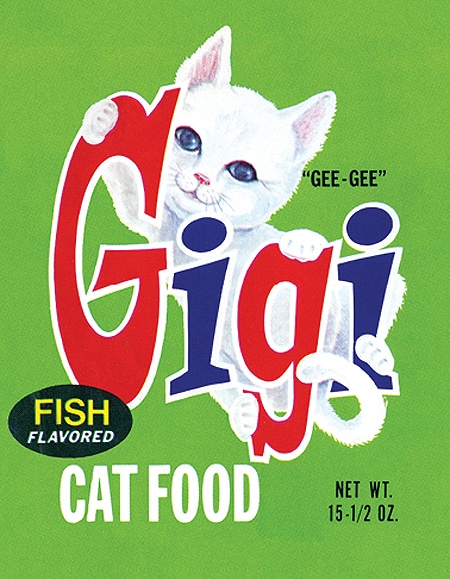
What do these cat-product labels tell us about ourselves as individuals, or our society overall?
MH: First of all, the brand names of the labels and especially the feline imagery are cute and whimsical. They were made in a time unfettered by political correctness. The brand names and the poses of the cats on the labels tells us how much we love our pets. Pets give us a lot of pleasure and enjoyment — watching them evolve from kittens to full-grown cats. Cats teach us we can live in harmony with other species. They broaden our scope of interaction. What matters to you also matters to the cat, in some way. It makes us better people.
What do they tell us about our relationships with our cats?
MH: The labels — and the quotes Warren found for each label — show us that cats have unique personalities. Cats demand our attention. They are solitary animals who sleep, eat, and hunt, but they just as much enjoy our company. They become a part of our lives and we reward them with food, shelter, and love. It is a mutually beneficial relationship. They provide us with a sense of belonging and family by participating in our lives, too. They give us pause about the cares of the world. Believe me, it’s wonderful to be involved with your companion pet for a few minutes or a few hours and forget about the cares of the world.
Some of these labels surely will horrify modern-day cat-owners with things such as by-products and barley listed as selling points. What can you say about the evolution of pet food, its product design or what stage these labels represent?
MH: As a cat owner, I was surprised to see these ingredients such as by-products and also labels purporting that the food was good for both dogs and cats! I suppose at the time it wasn’t known that these were not good things. In fact, the brands in the book were mainly “local” brands so there was a level of trust associated with the brands … not as commercialized as brands today.
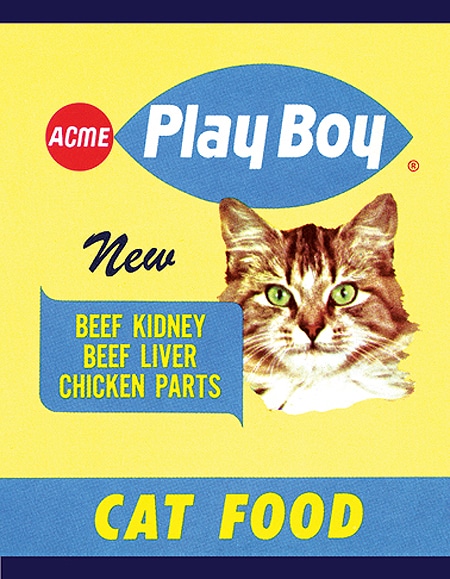
Some of the labels also contain really funny contradictions. Play Boy cat food lists in big type, “Beef Kidney, Beef Liver, Chicken Parts.” And Kitty Queen has an illustration of an adorable cat in a crown followed by the words, “Chopped Kidney.” This kind of absurdity, to me, speaks directly to cats’ existence — and also the things a cat owner not only faces but embraces. What’s your take on this?
WD: Well, we had a decision to make when we were designing the book. Can a beautiful art book reference “chopped kidney”? And the answer was that the labels are what they are. They’re very cute, but there’s a little bit of gore, too. But actually isn’t a cat’s existence from day-to-night just like that, mainly cute and sometimes gory?
MH: The imagery, for example, of Kitty Queen implies that your cat is getting choice products, but in reality he was getting chopped kidney. You see these brands appealing to the consumers’ vanity and ego. Pet owners at the time probably would have imagined their cats eating food they would like to eat. Not what these brands are serving.
Another label we found especially hilarious is Kitty Comfort Spray. It’s for a flea and tick remedy, but it looks as if the cat is applying deodorant. What do you think was the reasoning behind that label?
WD: I think this label is much more successful than its competitor’s labels, which, I assume, depicted images of fleas and ticks. People love cartoonish cats. Especially anthropomorphized cats who have opposable thumbs who are able to spray on deodorant like humans do. This was such a great label that I decided to expand the book’s horizon to present more than just pet-food labels. So there are kitty litter and catnip labels as well.
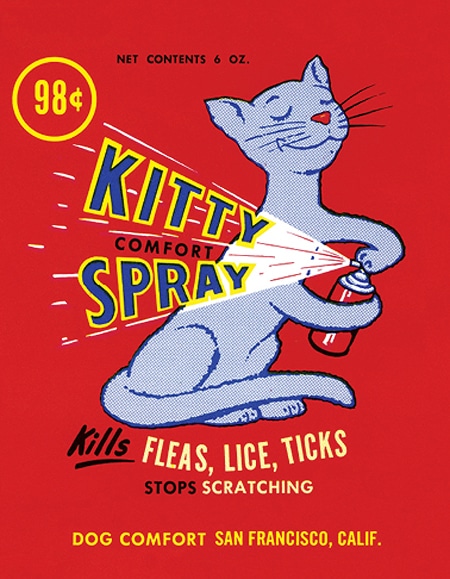
When did commercial pet food come into being? Grain and by-products aside, what did the type of cat food depicted in the labels from this era do for domesticated cats?
WD: Actually, our book has a brief history of cat food through the ages to put the label art in perspective for our readers. We chose some of the more modern labels — by that I mean labels from the late 1950s, ’60s, and ’70s. Although the “flower power” generation’s interest in health in the late 1960s was just beginning, it had not hit the pet food industry. It was nothing like what goes on today with real science dictating what goes into pet food. As to the nutrition value of the pet food of that time, [we’re] not pet nutritionists, but as we write in the book, “The availability of supermarket-bought pet food meant that cat owners could take the task of feeding their pets out of the animals’ paws and into their own. For domesticated cats, this cut down on the poor nutrition and disease that sometimes arose when kittens were left to scavenge on their own.”
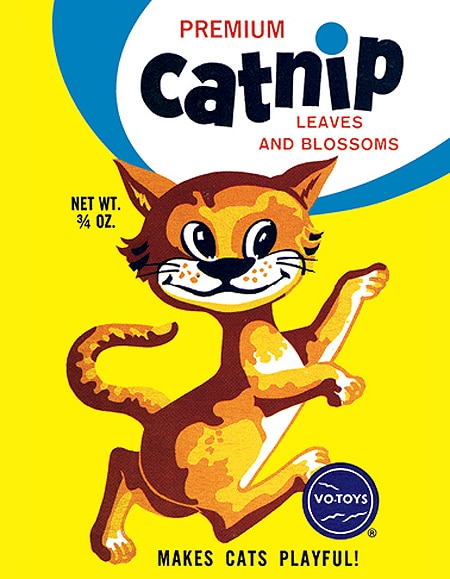
What roles do cats play in your lives? Have either or both of you lived with cats?
WD: As a kid growing up, my older brother had what I thought was the coolest after-class job of filling up the soda vending machines on his college campus. He also emptied out the change and had these shoes boxes at home filled with all the coinage. One hot summer he also brought home a pet kitten who liked to sit and sleep in the boxes because the coins felt nice and cool to her, and I named her Nickels. By the way, that name and image would make a great vintage label — I see the “5 cents off” starburst in the label corner.
MH: My wife has always owned cats, so when I married her I inherited three of them. I was never a cat owner, I was a dog person. But my acceptance of cats was unconditional. Life has been a series of cats ever since, about nine of them, from Mickey (Mantle) to Coco, who is my cat now. She’s a Maine Coon. Coco is very attached to me but skittish and scared of people. If she hears a noise, she hides. She won’t even let Warren pet her. But with me she’s the most attention-grabbing cat I’ve ever had. When I watch TV and get engrossed, I look down, and she’s sleeping in my lap. My wife is jealous that the cat spends more time with me than her.

Which labels are your respective favorites in the book, and why?
MH: I like Sassy, the one Warren mentioned as his inspiration for starting his collection. Because the face of the cat personifies cats. A snapshot of cats I’ve had. It’s playful, lovable, and memorable. I also like Cat Comfort litter label. It depicts three cats in a row singing together. It reminds me of the Supremes. And it also reminds me of cats when I was growing up in Bangladesh sitting on the edge of a wall crying out.
Which cat quotations do you like the best?
MH: I like Roger Carras’ quote, “Anyone who has owned cats in long succession can define their lives as a series of furry episodes.” I also like the quote my co-author, Warren, offered for the label of a cat dressed up as a dashing captain (Capt. Kitt): “Cat — Companion in beauty, grace, mystery, and adventure.”
Thanks, guys. Enlightening stuff.
We looked online and couldn’t find that old Meow Mix TV commercial, but the one above is one of several newer adaptations we found.
Do you have any funny stories involving labels on cat products, new or old? What is your favorite label or commercial? Do you remember the Tender Vittles ad featuring “The Clump?” Have you eaten kibble yourself? Tell us in the comments!



